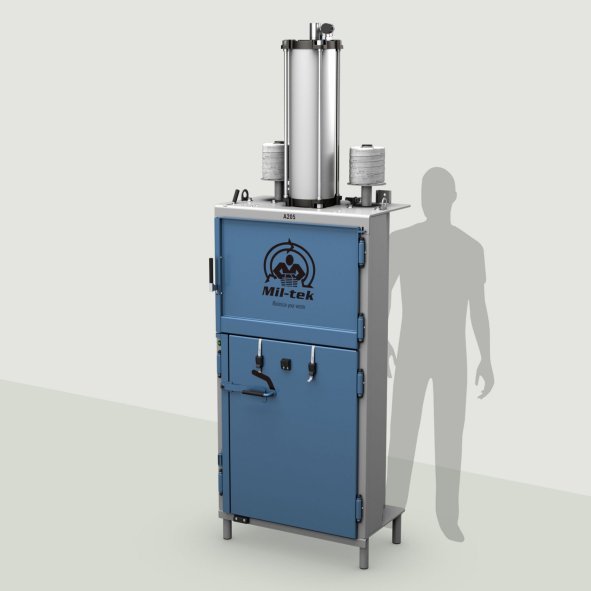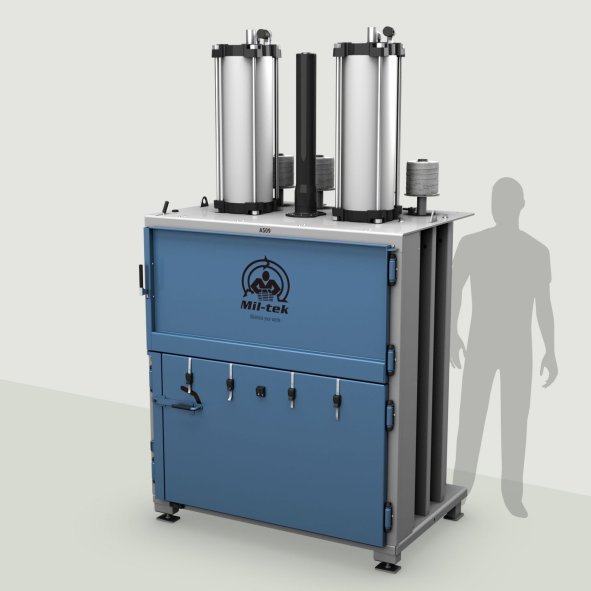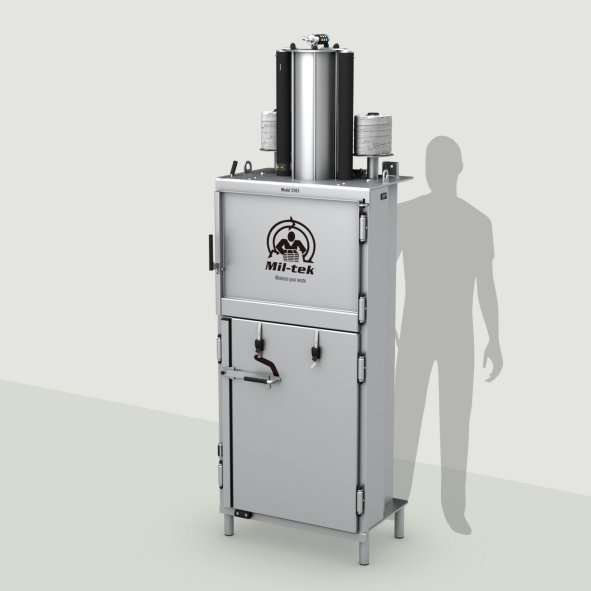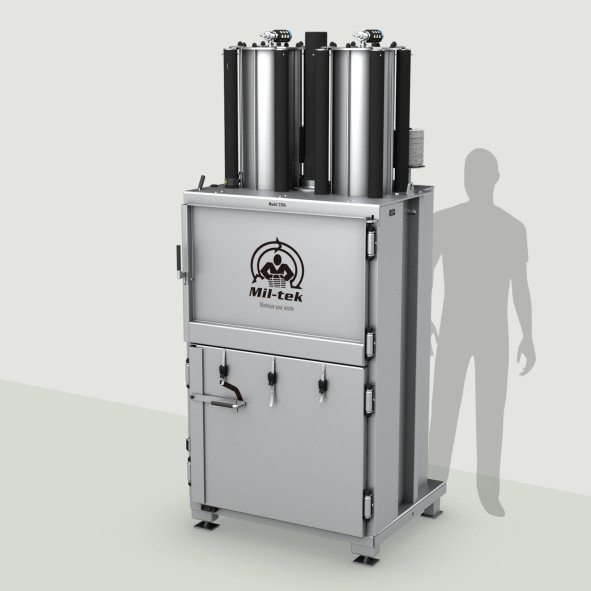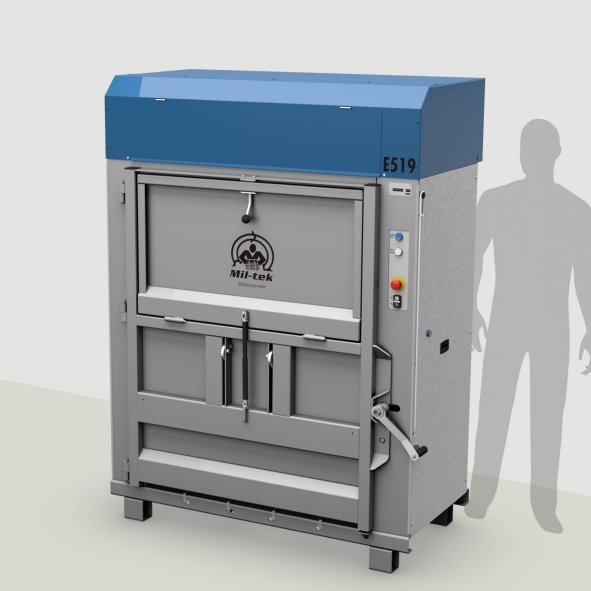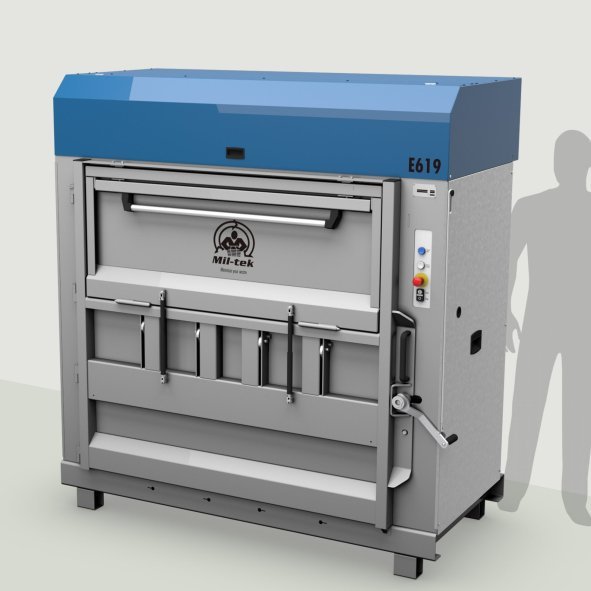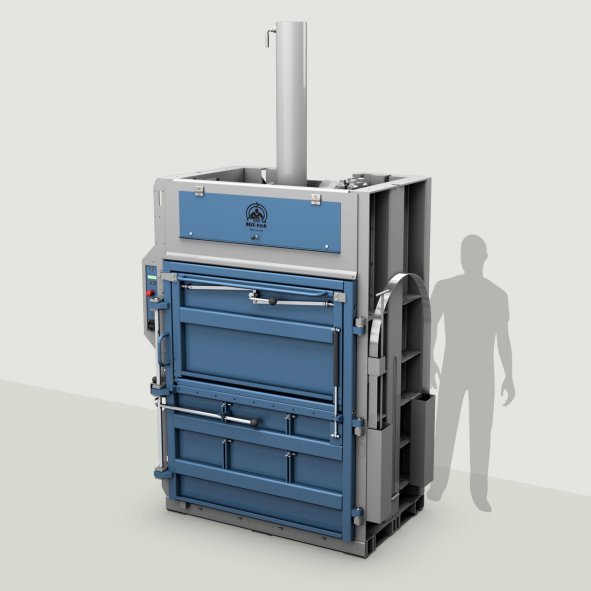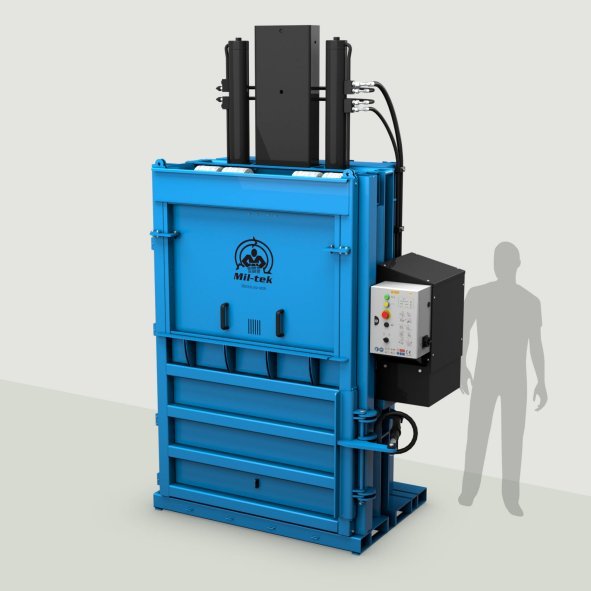
Vertical Balers – Compact waste management machines designed to compact recyclable materials
What is a vertical baler?
A vertical baler compacts waste like cardboard, plastic wrap, paper, PET bottles, and big bags into manageable bales for easier storage and transport. It operates by loading waste from the front or top, then compressing it downward using a vertical ram.
This combination of compact design and operational efficiency makes vertical balers particularly well-suited for small to medium-volume waste producers. They are ideal for settings where space is limited, such as retail stores, restaurants, and workshops, offering powerful performance without requiring a large footprint.
Key advantages include:
- Minimal footprint, ideal for tight spaces
- Lower upfront cost compared to larger balers
- Smaller bales that are easy to handle and store
- Reduced disposal costs through improved recycling


Key benefits of using a vertical baler
Beyond space efficiency, vertical balers offer significant cost savings. By reducing the frequency of skip pickups, businesses can cut ongoing waste disposal expenses. Even the smaller bales produced by vertical models can be sold to recyclers, turning waste into a potential revenue stream.
Environmental and operational benefits
Vertical balers can also support sustainability goals. By compacting waste onsite, you reduce the number of collections needed, which lowers fuel use and CO2 emissions. Additionally, less waste volume means lower energy and transportation costs, contributing to a greener operation.
In short, vertical balers provide a cost-effective, eco-conscious, and space-efficient waste management solution – without compromising on performance or material handling flexibility.

Materials that can be baled
Don’t let their small size fool you, vertical balers are impressively versatile. They can handle a wide range of materials, including:
- Cardboard
- Plastic wrap
- PET bottles
- And more
Versatile baling for mixed waste streams
The flexibility of vertical balers to handle different kinds of recyclables makes them ideal for businesses with mixed waste streams. However, it is always essential to check each baler’s specifications to ensure it suits your waste type and volume. The density, rebound properties, and volume of materials can affect performance and bale quality.
Whether you’re primarily dealing with packaging waste or not, we offer a variety of specialized models to match your needs.

Explore our vertical cardboard balers or plastic balers to find the right fit !
Space requirements and installation
Vertical balers are designed with space efficiency in mind, making them ideal for businesses with limited room. Most models have a footprint of less than 2 m², with typical dimensions ranging between 1–1.5 meters wide and 1–2 meters deep. This compact size allows for easy placement in back rooms, storage areas, or tight corners of retail, hospitality, or service environments.
Power and placement requirements
Vertical balers typically run on either compressed air or single- or three-phase electricity. Make sure your site has the appropriate power or air supply. For safe and efficient operation, place the baler where staff can easily load materials and remove bales, and ensure it’s positioned on solid, level flooring.
Future-proof your setup
For businesses expecting growth in waste volume, consider positioning your baler in a spot that allows for future expansion or machine upgrades. Proper planning helps ensure efficient, safe operation, and that your baler continues to meet your needs as they evolve.


Safety features and best practices
Operating a vertical baler safely starts with proper training and understanding the manual.
Modern vertical balers like Mil-tek’s are equipped with key safety mechanisms, such as door interlocks that prevent the machine from operating while the chamber is open. It’s also critical to keep hands, clothing, and tools away from the compression zone at all times during operation.
Ongoing training and awareness
Maintaining a high level of ongoing staff awareness is equally important. This includes regular refresher training, clearly posted safety signage, and consistent supervision. These practices help prevent accidents, especially in busy environments like retail or hospitality.
By following safety best practices and using the built-in protections of your machine, you create a safer workspace while ensuring the long-term reliability of your baler. Always treat the baler as industrial equipment, not a routine appliance.

Maintenance and upkeep
Regular maintenance is key to keeping your vertical baler running safely and efficiently. Routine checks should include cleaning the machine, lubricating moving parts, and inspecting for signs of wear and tear, such as frayed belts or damaged components. It’s also important to inspect hydraulic systems, tension settings, and power connections to ensure everything is functioning properly.
Schedule regular maintenance
To prevent downtime, consider scheduling maintenance on a monthly or quarterly basis, depending on how often the machine is used. High-volume users may require more frequent inspections to catch minor issues before they become major problems.
Train staff for early detection
Proper staff training not only ensures safe operation but also helps identify early signs of malfunction, reducing the risk of breakdowns. Keeping your baler in top condition extends its lifespan, improves safety, and ensures consistent performance. A well-maintained baler is a reliable part of your waste management routine, and a smarter investment long term.

How to choose the right vertical baler 💡
1. Assess your needs – Start by considering:
The types of materials you’ll be baling
The amount of waste you generate
Your available space
Your budget
2. Match the machine to your output
Baler models produce bales ranging from around 50 kg to 500 kg, so be sure to choose a size and capacity that fits your waste volume.
3. Look at key features
Important factors include:
Noise levels
Cycle times
Ease of tying off and removing bales
User-friendly controls (especially important for frequent use)
4. Decide between leasing or buying
Leasing offers flexibility and lower upfront costs
Buying may offer better long-term ROI by avoiding recurring payments
5. Get tailored support
Whether you’re a small retailer or a growing business, we’re here to help you find the perfect vertical baler to streamline your waste management.
If you’re handling larger volumes and have more floor space, a horizontal baler may be a better fit than a vertical baler. To learn more about horizontal options, see our Horizontal Baler page.
Costs associated with purchasing and operating a vertical baler
While a vertical baler requires an upfront investment, it can deliver substantial long-term savings through reduced waste handling costs and increased recycling revenue. Understanding the different cost factors helps you plan more effectively and maximize your return on investment (ROI).
Initial investment:
– Cost of the baler unit (varies by size and features)
– Installation and transport fees
Potential ROI:
– Fewer skip pickups lower disposal costs
– Revenue from selling baled recyclables like cardboard and plastic
Ongoing operating costs:
– Low electricity usage per cycle
– Routine maintenance and occasional repairs
Long-term savings:
– Significant cost reduction compared to ongoing skip hire
– Improved operational efficiency and sustainability
Whether leasing or buying, a vertical baler is a cost-effective choice for businesses looking to manage waste more efficiently and profitably over time.

Need help choosing the right vertical baler?
If you’re dealing with limited space and moderate waste, a vertical baler helps you stay efficient and save costs.
Contact us via the form for personalized advice, or explore our full product range here:

